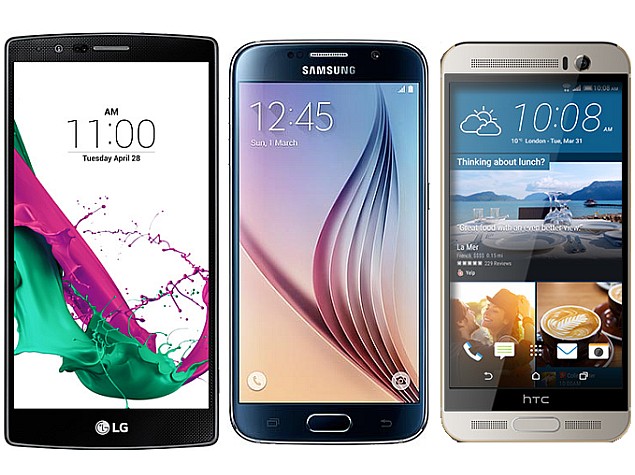- Home
- Mobiles
- Mobiles Features
- LG G4 vs Samsung Galaxy S6 vs HTC One M9+
LG G4 vs Samsung Galaxy S6 vs HTC One M9+

While the HTC One M9 is being touted as the Taiwanese firm's flagship, the HTC One M9+ seems to be the higher-end offering, featuring a QHD display instead of a full-HD one, as well as a fingerprint sensor. It is for that reason we have chosen to compare the One M9+ with LG and Samsung's 2015 flagships, notwithstanding HTC's use of a MediaTek processor in a top-end smartphone.
(Also see: LG G4 vs Samsung Galaxy S6 vs HTC One M9+ Specifications Comparison)
Starting with the design, LG has gone out of its way to ensure its new flagship appeals to the fashionable with the choice of leather, ceramic, and metal finishes, while also looking to provide an ergonomic form factor. Eschewing slimness for the overall design, LG has made the G4 9.8mm thick at its thickest point, and 6.3mm thick at its thinnest, causing the prominent curve on the back panel that's meant to help hold the smartphone comfortably.
With the G4, LG has once again used its rear button interface first introduced with the LG G2, and apart from the screen size and resolution, this appears to be the only major similarity between the LG G3 and LG G4's designs. On the other hand, HTC's latest flagship is nearly identical to last year's HTC One (M8), with the M9+'s physical home button (not present on the One M9) the only major difference.
On this front, Samsung with its Galaxy S6 (Review | Images)and Galaxy S6 Edge (Review | Images) has won quite some praise for completely reworking its smartphone design philosophy. Featuring a metal and glass build, the design of the Galaxy S6 however has also been not too unfairly compared with that of Apple's iPhone 6, with similar rounded corners, curved edges, and speaker grilles.
Of the three phones, Samsung's Galaxy S6 is the slimmest at 6.8mm, and also the lightest, at 138 grams. The One M9+ on the other hand is 9.61mm at its thickest, and is the heaviest of the three weighing in at 168 grams compared to the LG G4's 155 grams. If slimness is not a concern, LG with its bold design choices may be the winner on this front - especially when considering the choice of materials on offer for the user.
Coming to the display, and we observe all three smartphones offer a Quad-HD or 2K resolution of 1600x2560 pixels - however, the screen sizes and technology differs. The LG G4 sports a 5.5-inch Quantum IPS display with a pixel density of 538ppi, the Samsung Galaxy S6 a 5.1-inch Super-Amoled display with a pixel density of 577ppi, and the HTC One M9+ a 5.2-inch Super-LCD3 display with a pixel density (not officially published) that's roughly comparable to Galaxy S6. Samsung appears to have the winner in this case, in terms of pixel density, though LG's quick to point out its Quantum Dot display offers "20 percent greater colour reproduction, 25 percent improvement in brightness and 50 percent greater contrast" compared to conventional panels. A real world comparison would be required to judge the winner.
On the processor front, we know that LG decided to go with the hexa-core Snapdragon 808 processor rather than the current top-end SoC from Qualcomm - the octa-core Snapdragon 810, which has seen multiple reports about overheating problems that the chipmaker says have since been fixed. While early benchmarks have shown the octa-core Exynos 7420 in the Galaxy S6 to perform very well versus other top-end chipsets, the One M9+'s octa-core MediaTek MT6795T is not too far behind, with other benchmarks pegging it ahead of the Snapdragon 810 in some tests. More recent benchmarks that include the Snapdragon 808 place it far behind. Of the three, LG's choice is certainly the most conservative, but the company is touting impressive performance that's coupled with all-day battery life, instead of industry-leading performance. We will have to wait to perform our own benchmarks on all three devices to properly peg relative performance.
Speaking about the battery, LG has stuck with the tried and tested philosophy of providing a removable battery for pro users who would rather swap out their battery when running low on charge on the move, rather than place their phone on charge or connect it to a power bank. LG's decision is most notable in this comparison as both the HTC One M9+ and Samsung Galaxy S6 don't have a removable battery to offer. The G4 has the largest battery capacity amongst the three, at 3000mAh, compared to the S6's 2550mAh, and the One M9+'s 2840mAh battery. To be noted is that the G4 also has the largest display and would thus require a bigger battery to power it despite sporting approximately the same number of pixels. Samsung touts nativewireless charging, a feature available on LG's G4 only with a separate accessory. Both the LG G4 and Samsung Galaxy S6's batteries support Qualcomm's Quick Charge 2.0 fast charging feature.
We next come to storage, and see that the base models of all three smartphones sport 32GB of storage. While the LG G4 and HTC One M9+ come with no higher built-in storage variants, both the smartphones offer storage expandability support via microSD card up to a maximum of 2TB. Samsung's Galaxy S6 on the other hand has no microSD card slot. So while it is hard to decide a winner here, the Galaxy S6 certainly seems to be on the losing end with most prosumers looking to augment their phone's storage, and enjoy the ability to swap out data as easily as changing a memory card.
On the camera front, as with previous smartphone comparisons, we reiterate that it is almost impossible to compare cameras based purely on pixel count, and the output quality is all that matters. Most end-users never actually use their captured images at full-resolution, and simply share their photos on social media or apply them as wallpapers. Only professional photographers need to worry about pixel count, that too when blowing up images for specific purposes. For a more accurate real world camera performance comparison, we urge you to wait for our LG G4 review.
On paper, both the LG G4 and Samsung Galaxy S6 have 16-megapixel rear cameras, with the G4 featuring an f/1.8 aperture lens, and the S6 an f/1.9 lens. LG says the difference between the two aperture sizes is not insignificant, and allows 11 percent more light to enter. Comparing it to the f/2.4 lens on the G3, LG says it is 80 percent brighter. The HTC One M9+ features a 20.7-megapixel Duo rear camera, coupled with an f/2.2 lens. LG is also touting the best optical image stabilisation in the market, with OIS 2.0 that uses the z-axis for the first time. Alongside, it allows users to save their photos in RAW format. It also sports what is being claimed to be the industry's first Color Spectrum Sensor (CSS) that by reading the values of both the RGB and infrared light in a scene can auto adjust flash and colour temperature to ensure colour accuracy.
As for the front-facing camera, the LG G4 features an 8-megapixel offering with an f/2.0 lens. The HTC One M9+ bears a 4-UltraPixel sensor with an f/2.0 aperture, while the Samsung Galaxy S6 bears a 5-megapixel offering with an f/1.9 aperture.
LG certainly seems to have made some right decisions, judging by the interest surrounding the phone since its launch on Tuesday. The company appears to have straddled the line between style and performance well, and we expect LG may have another winner on its hands, despite not having the novelty value the G3 had by being the only QHD display smartphone on the market for a while. Stay tuned for a detailed review.Catch the latest from the Consumer Electronics Show on Gadgets 360, at our CES 2026 hub.
Related Stories
- Samsung Galaxy Unpacked 2025
- ChatGPT
- Redmi Note 14 Pro+
- iPhone 16
- Apple Vision Pro
- Oneplus 12
- OnePlus Nord CE 3 Lite 5G
- iPhone 13
- Xiaomi 14 Pro
- Oppo Find N3
- Tecno Spark Go (2023)
- Realme V30
- Best Phones Under 25000
- Samsung Galaxy S24 Series
- Cryptocurrency
- iQoo 12
- Samsung Galaxy S24 Ultra
- Giottus
- Samsung Galaxy Z Flip 5
- Apple 'Scary Fast'
- Housefull 5
- GoPro Hero 12 Black Review
- Invincible Season 2
- JioGlass
- HD Ready TV
- Laptop Under 50000
- Smartwatch Under 10000
- Latest Mobile Phones
- Compare Phones
- OPPO Reno 15 Pro Max
- Honor Win RT
- Honor Win
- Xiaomi 17 Ultra Leica Edition
- Xiaomi 17 Ultra
- Huawei Nova 15
- Huawei Nova 15 Pro
- Huawei Nova 15 Ultra
- Asus ProArt P16
- MacBook Pro 14-inch (M5, 2025)
- OPPO Pad Air 5
- Huawei MatePad 11.5 (2026)
- Xiaomi Watch 5
- Huawei Watch 10th Anniversary Edition
- Acerpure Nitro Z Series 100-inch QLED TV
- Samsung 43 Inch LED Ultra HD (4K) Smart TV (UA43UE81AFULXL)
- Asus ROG Ally
- Nintendo Switch Lite
- Haier 1.6 Ton 5 Star Inverter Split AC (HSU19G-MZAID5BN-INV)
- Haier 1.6 Ton 5 Star Inverter Split AC (HSU19G-MZAIM5BN-INV)




















